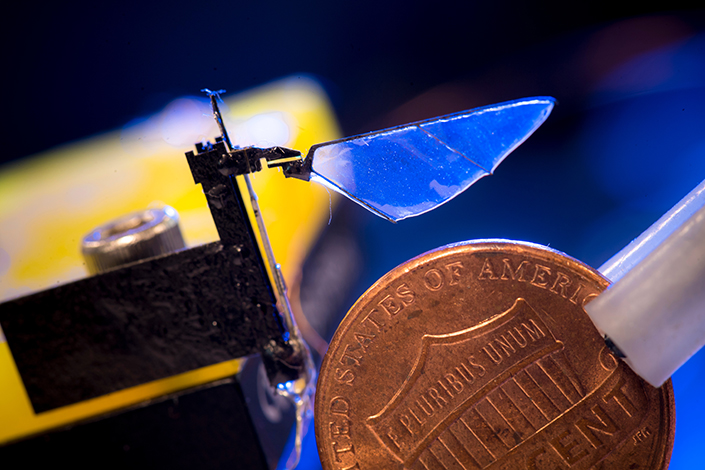These Robots Helped Understand How Insects Evolved Two Distinct Strategies of Flight
Story by:
Published Date
Article Content
Robots built by engineers at the University of California San Diego helped achieve a major breakthrough in understanding how insect flight evolved, described in the Oct. 4, 2023 issue of the journal Nature. The study is a result of a six-year long collaboration between roboticists at UC San Diego and biophysicists at the Georgia Institute of Technology.
The findings focus on how the two different modes of flight evolved in insects. Most insects use their brains to activate their flight muscles each wingstroke, just like we activate the muscles in our legs every stride we take. This is called synchronous flight. But some insects, such as mosquitoes, are able to flap their wings without their nervous system commanding each wingstroke. Instead, the muscles of these animals automatically activate when they are stretched. This is called asynchronous flight. Asynchronous flight is common in some of the insects in the four major insect groups, allowing them to flap their wings at great speeds, allowing some mosquitoes to flap their wings more than 800 times a second, for example.
For years, scientists assumed the four groups of insects–bees, flies, beetles and true bugs (hemiptera)– all evolved asynchronous flight separately. However, a new analysis performed by the Georgia Tech team concludes that asynchronous flight actually evolved together in one common ancestor. Then some groups of insect species reverted back to synchronous flight, while others remained asynchronous.
The finding that some insects such as moths have evolved from synchronous to asynchronous, and then back to synchronous flight led the researchers down a path of investigation that required insect, robot, and mathematical experiments. This new evolutionary finding posed two fundamental questions: do the muscles of moths exhibit signatures of their prior asynchrony and how can an insect maintain both synchronous and asynchronous properties in their muscles and still be capable of flight?
The ideal specimen to study these questions of synchronous and asynchronous evolution is the Hawkmoth. That’s because moths use synchronous flight, but the evolutionary record tells us they have ancestors with asynchronous flight.
Researchers at Georgia Tech first sought to measure whether signatures of asynchrony can be observed in the Hawkmoth muscle. Through mechanical characterization of the muscle they discovered that Hawkmoths still retain the physical characteristics of asynchronous flight muscles–even if they are not used.
How can an insect have both synchronous and asynchronous properties and still fly? To answer this question researchers realized that using robots would allow them to perform experiments that could never be done on insects. For example, they would be able to equip the robots with motors that could emulate combinations of asynchronous and synchronous muscles and test what transitions might have occurred during the millions of years of evolution of flight.
The work highlights the potential of robophysics–the practice of using robots to study the physics of living systems, said Nick Gravish, a professor of mechanical and aerospace engineering at the UC San Diego Jacobs School of Engineering and one of the paper’s senior authors.
“We were able to provide an understanding of how the transition between asynchronous and synchronous flight could occur,” Gravish said. “By building a flapping wing robot, we helped provide an answer to an evolutionary question in biology.”
Essentially, if you’re trying to understand how animals–or other things–move through their environment, it is sometimes easier to build a robot that has similar features to these things and moves through the same environment, said James Lynch, who earned his Ph.D. in Gravish’s lab and is one of the lead co-authors of the paper.
“One of the biggest evolutionary findings here is that these transitions are occurring in both directions, and that instead of multiple independent origins of asynchronous muscle, there's actually only one,” said Brett Aiello, an assistant professor of biology at Seton Hill University and one of the co-first authors. He did the work for his study when he was a postdoctoral researcher in the lab of Georgia Tech professor Simon Sponberg. “From that one independent origin, multiple revisions back to synchrony have occurred.”

Photos: Erik Jepsen/University of California San Diego
Findings, challenges and next steps
The robot and modeling experiments helped researchers test how an insect could transition from synchronous to asynchronous flight. For example, researchers were able to create a robot with motors that could combine synchronous and asynchronous flight and see if it would actually be able to fly. They found that under the right circumstances, an insect could transition between the two modes gradually and smoothly.
“The robot experiments provided a possible pathway for this evolution and transition,” Gravish said.
Lynch encountered several challenges, including modeling the fluid flow around the robots, and modeling the feedback property of insect muscle when it’s stretched. Lynch was able to solve this by simplifying the model as much as possible while making sure it remained accurate. After several experiments, he also realized he would have to slow down the movements of the bots to keep them stable.
Next steps from the robotics perspective will include working with material scientists to equip the flappers with muscle-like materials.
In addition to helping clarify the evolution and biophysics of insect flight, the work has benefits for robotics. Robots with asynchronous motors can rapidly adapt and respond to the environment, such as during a wind-gust or wing collision,Gravish said. The research also could help roboticists design better bots with flapping wings.
“This type of work could help usher in a new era of responsive and adaptive flapping wing systems,” Gravish said.
Biophysical transitions in insect flight dynamics are bridged by common muscle physiology
James Lynch and Nick Gravish, University of California San Diego
Jeff Gau, Brett Aiello, Ethan Wold and Simon Spoonberg, Georgia Institute of Technology
Share This:
Stay in the Know
Keep up with all the latest from UC San Diego. Subscribe to the newsletter today.



